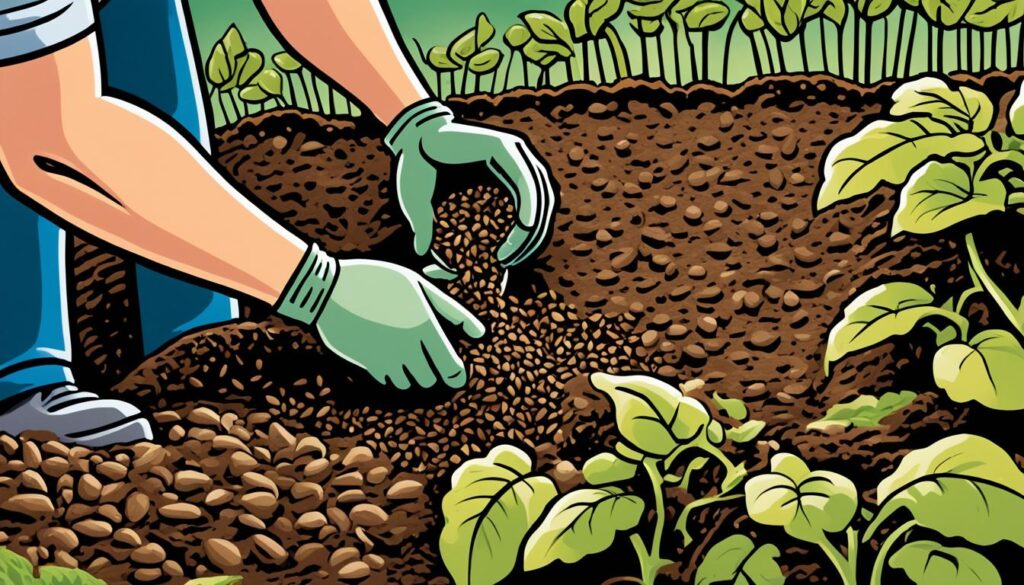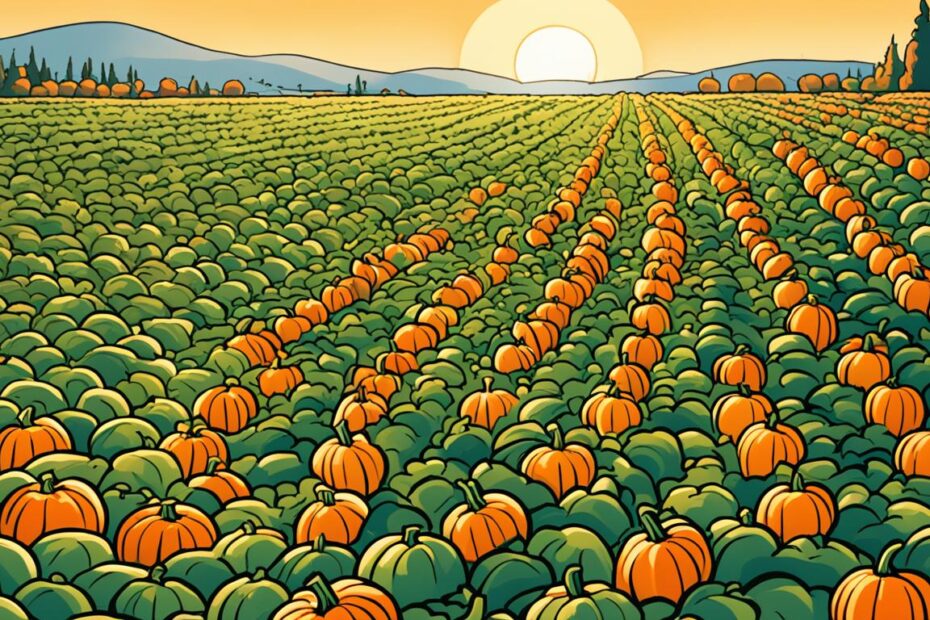When it comes to growing pumpkins, there are a lot of factors to consider – soil quality, proper watering, pest management, and more. But have you ever wondered if pumpkins prefer acidic soil? Does it make a difference in their growth and overall health?
Join us as we delve into the fascinating world of pumpkin cultivation and explore the relationship between pumpkins and acidic soil. Discover the secrets to nurturing thriving pumpkin plants and uncover the truth behind this gardening curiosity.
- Understanding the optimal growing conditions for pumpkins
- The importance of well-drained soil and proper pH levels
- Tips for fertilizing and caring for pumpkin plants
- Exploring different pumpkin varieties and their characteristics
- Maximizing pumpkin yield by implementing effective gardening techniques
Selecting the Right Type of Pumpkin to Grow
When it comes to growing pumpkins, selecting the right variety is key to a successful harvest. With a wide range of options available, it’s important to consider various factors before choosing the perfect pumpkin seeds for your garden.
Pumpkin Varieties:
There are numerous pumpkin varieties to choose from, each with its own unique characteristics. Some pumpkins are specifically bred for carving, while others are better suited for culinary use or decorative purposes. Consider your intended use for the pumpkins and select a variety that aligns with your goals. Whether you’re looking to create spooky jack-o’-lanterns, bake delicious pies, or enhance your fall displays, there’s a perfect pumpkin variety for every purpose.
Size Matters:
Pumpkins come in a variety of sizes, from mini pumpkins that fit in the palm of your hand to jumbo pumpkins that can weigh over 100 pounds. Keep in mind that the size of the pumpkin plant will directly impact the size of the pumpkins it produces. If you have limited space in your garden, opt for smaller varieties that are more compact and manageable. If you have ample space or are looking to grow giant pumpkins, choose varieties known for producing larger fruits. Consider your available garden space and desired pumpkin size when selecting seeds.
Climate and Growing Season:
Another important factor to consider is your climate and the length of your growing season. Different pumpkin varieties have varying days to maturity, meaning some pumpkins take longer to reach full maturity and are best suited for longer growing seasons. Research the average frost dates in your area and select pumpkin seeds that have enough time to mature before the first frost. This will ensure that your pumpkins have ample time to grow and ripen before the colder weather sets in.
Disease Resistance:
Pumpkins can be susceptible to various diseases, such as powdery mildew, downy mildew, or vine borers. To minimize the risk of disease and maximize your chances of a healthy harvest, consider selecting pumpkin varieties that have been bred for disease resistance. These varieties are more likely to withstand common pumpkin diseases, reducing the need for extensive pest and disease management.
“The right pumpkin variety can make all the difference in your garden. Choose wisely and enjoy the bountiful rewards.”
By taking into account factors such as variety, size, climate, and disease resistance, you can make an informed choice when selecting pumpkin seeds. This will help ensure that your pumpkin plants thrive in your garden and produce the perfect pumpkins for your intended use or décor.
Popular Pumpkin Varieties
| Variety | Use | Size | Days to Maturity | Disease Resistance |
|---|---|---|---|---|
| Jack O’Lantern | Carving | Medium | 90-100 | Fair |
| Sugar Pie | Baking | Small to Medium | 90-110 | Good |
| Atlantic Giant | Competitive Growing | Jumbo | 120-150 | Poor |
| Miniature Jack | Decoration | Mini | 60-80 | Good |
Preparing Your Garden Site to Grow Pumpkins
If you want to grow healthy and vibrant pumpkins, preparing your garden site is essential. This includes soil preparation, conducting a soil test, and practicing crop rotation. By following these steps, you can create an optimal environment for your pumpkin plants to thrive.
Soil Preparation
Before planting your pumpkin seeds, it’s crucial to enhance the quality of the soil. Adding compost or well-rotted manure is an excellent way to provide organic matter, improve soil fertility, and promote nutrient availability. These organic materials help retain moisture, enhance soil structure, and encourage beneficial microorganisms to thrive.
When preparing the soil, ensure it is well-drained to prevent waterlogging, which can lead to root rot and other soil-borne diseases. Amending the soil with organic matter will also improve drainage, creating an ideal growing environment for your pumpkins.
Conducting a Soil Test
To ensure your pumpkin plants have the necessary nutrients, conducting a soil test is highly recommended. A soil test provides valuable information about the pH levels and nutrient content of your soil. This allows you to make any necessary adjustments to provide optimal growing conditions for your pumpkins.
Soil pH affects the availability of nutrients to your plants. Pumpkins thrive in slightly acidic to neutral soil, with a pH range of 6.0 to 6.8. If your soil pH falls outside this range, you can adjust it by adding amendments such as lime to increase pH or sulfur to decrease pH.
Crop Rotation
Crop rotation is an important practice in pumpkin cultivation. By rotating the location where you grow your pumpkins each year, you can minimize the risk of diseases and pests that target pumpkins. This helps maintain soil health and balance nutrient requirements.
When implementing crop rotation, avoid planting pumpkins in the same spot for at least three years. Instead, rotate with crops from different families, such as legumes, brassicas, or root vegetables. This disrupts the life cycles of pests and pathogens, reducing the likelihood of infestations and diseases.
To summarize:
- Enhance soil quality by adding compost or well-rotted manure.
- Conduct a soil test to determine pH levels and nutrient content.
- Adjust soil pH if necessary to provide optimal growing conditions.
- Practice crop rotation to maintain soil health and minimize disease risks.

By taking the time to prepare your garden site, you are setting the stage for successful pumpkin growth. The next section will guide you through the step-by-step process of planting your pumpkin seeds and nurturing your plants as they grow.
Step-by-Step Guide to Planting Pumpkins
Planting pumpkins is an exciting and rewarding experience. Whether you’re a seasoned gardener or a beginner, this step-by-step guide will help you successfully plant and grow your own pumpkins. By following these instructions, you’ll be on your way to a bountiful harvest of vibrant, plump pumpkins.
1. Choosing the Right Time
The first step in planting pumpkins is selecting the right time. Wait until all frost danger has passed and the soil temperature is consistently above 60°F. Pumpkins are warm-weather plants and need the right conditions to germinate and thrive.
2. Starting Seeds Indoors
For a head start on the growing season, you can start pumpkin seeds indoors a couple of weeks before the last frost. Use seed trays or pots filled with seed-starting mix. Plant the seeds about an inch deep and keep them moist. Place the trays in a warm location with plenty of sunlight.
3. Transplanting Seedlings Outdoors
Once your pumpkin seedlings have several leaves and the risk of frost has passed, it’s time to transplant them outdoors. Choose a sunny location in your garden with well-drained soil. Prepare hills that are 20 feet apart to allow ample room for growth.
When transplanting, be gentle with the seedlings and avoid disturbing the roots. Place one plant per hill, burying the stem up to the first set of leaves. This helps the plant develop a strong root system.
After planting, water the seedlings thoroughly and protect them from harsh elements, such as strong winds or intense sunlight. You can use row covers or cloches to provide temporary shelter until the seedlings establish themselves.
4. Support and Spacing
Pumpkin plants are vigorous growers and require support as they spread. You can use trellises, fences, or stakes to guide the vines and keep them off the ground. This helps improve air circulation and prevents diseases.
Spacing is also crucial for healthy pumpkin growth. Leave at least 20 feet between hills to allow ample room for the vines to extend and produce foliage and pumpkins. This spacing ensures access to sunlight and encourages good air circulation.
5. Continued Care
Once your pumpkin plants are established, they require consistent care. Regular watering is critical, especially during dry spells. Keep the soil evenly moist, but avoid overwatering, as it can lead to rot and disease.
Mulching around the plants can help retain moisture and suppress weed growth. Organic mulch, such as straw or shredded leaves, also enriches the soil as it breaks down.
As the pumpkins develop, you can apply a balanced fertilizer to promote healthy growth and fruit production. Follow the manufacturer’s instructions for dosage and application.
“Planting pumpkins is an art that involves patience, nurturing, and attention to detail. By starting your seeds indoors and transplanting the seedlings outdoors, you’re giving your pumpkins the best possible start. Remember to provide support, ample spacing, and ongoing care. With proper dedication, you’ll soon be rewarded with a harvest of delicious pumpkins.”
| Step | Instructions |
|---|---|
| 1 | Choose the right time to plant, after all frost danger has passed and the soil temperature is above 60°F. |
| 2 | Start pumpkin seeds indoors a couple of weeks before the last frost, using seed trays or pots filled with seed-starting mix. |
| 3 | After the last frost, transplant the seedlings outdoors to a sunny location with well-drained soil. |
| 4 | Provide support for the vines and leave at least 20 feet between hills for proper spacing. |
| 5 | Continue to care for the plants by watering, mulching, and fertilizing as needed. |
By following this step-by-step guide, you’ll be well on your way to planting healthy pumpkin seeds, starting them indoors, and transplanting the seedlings outdoors. Remember to provide the right conditions, support the vines, and space the plants adequately. Happy pumpkin growing!
How to Fertilize Pumpkin Plants
Pumpkin plants have both male and female flowers, and successful pumpkin flower pollination is essential for fruit set. To ensure effective pollination, follow these steps:
- Choose a strong vine with a female flower that is on the verge of opening.
- Protect the female flower from insects by covering it overnight with cheesecloth.
- In the morning, select a fresh male flower with a stamen covered in pollen.
- Rub the pollen-laden stamen around the center of the female flower bloom.
The continuous growth of the pumpkin depends on the vines, which require support from the natural root system. When the pumpkin plant reaches a certain length, pruning can redirect resources to the fruit. Adequate water and nutrients are crucial throughout the growing season to support pumpkin growth.
| Key Steps for Fertilizing Pumpkins: |
|---|
| 1. Choose a strong vine with a female flower. |
| 2. Cover the female flower overnight with cheesecloth. |
| 3. Rub the pollen-laden stamen of a male flower on the female bloom. |
| 4. Prune the pumpkin plant after reaching a certain length. |
| 5. Provide adequate water and nutrients throughout the growing season. |
Following these fertilization guidelines will maximize the chances of successful fruit development and help you grow healthy, vibrant pumpkins.
Growing Fall Pumpkins and Gourds
When it comes to growing pumpkins in the fall, a few key considerations can greatly contribute to the success of your harvest. Choosing the sunniest location in your garden is essential, as pumpkins thrive in full sunlight. This ensures that your pumpkins receive the maximum amount of warmth and light, allowing them to grow and mature properly.
In addition to sunlight, it’s crucial to protect your pumpkin plants from the elements. As fall weather can bring strong winds and unexpected frost, taking precautions is necessary. Shielding your pumpkins from wind can prevent damage to the vines and fruits, ensuring that they continue to grow uninterrupted. Likewise, covering your plants during heavy rains can prevent waterlogging and disease.
Consistent watering is another key aspect of growing pumpkins in the fall. Pumpkins have high water requirements, and providing adequate moisture is vital for their healthy development. It is recommended to water your pumpkins with 15 to 20 gallons of water per plant twice a week. To minimize the risk of disease, water should be applied at the base of the plant, keeping the leaves dry.
Protecting your pumpkins from extreme weather conditions is crucial for their overall health and growth. By choosing the sunniest location, shielding them from wind and frost, and ensuring consistent watering, you can create an optimal environment for your fall pumpkins to thrive.
How to Grow Pumpkins
Growing giant pumpkins requires careful attention to details such as seeds, soil, sunshine, and water. Follow these essential steps to ensure successful pumpkin growth and maximize the size of your pumpkins.
Choosing the Right Pumpkin Variety
When aiming for giant pumpkins, select varieties known for their exceptional size potential. Popular choices include Atlantic Giant, Big Max, and Dill’s Atlantic Giant. These varieties have been developed specifically for their ability to produce massive pumpkins.
Preparing the Soil
Start by choosing a location with full sun exposure as pumpkins need at least 6-8 hours of direct sunlight each day. Prepare the soil by incorporating organic matter such as well-rotted compost or aged manure. This will improve soil structure, increase nutrient availability, and promote healthy root development.
Providing Optimal Growing Conditions
Ensure your pumpkin plants receive adequate water and sunlight. Water deeply and regularly, especially during dry periods, to keep the soil evenly moist. Avoid overhead watering as it can encourage disease development. Consider using drip irrigation or a soaker hose to deliver water directly to the roots.
Maximize sunlight exposure by planting pumpkins in a well-draining, open area free from shading trees or nearby structures. Proper air circulation around the plants will help prevent diseases and promote vigorous growth.
Pruning and Plant Care
Pruning is crucial for growing giant pumpkins. Remove all but one or two female flowers per vine to redirect energy towards fruit development. Train the vines away from the fruit to avoid damage and provide proper support. Regularly check for pests or diseases and take immediate action to protect your plants.
The Growth and Weight of Pumpkins
Every leaf, stem, and root plays a vital role in the growth and weight of your pumpkins. Nurturing your plants throughout the growth stages is essential for their success. Encourage vegetative growth by applying nitrogen-rich fertilizers early in the season. As the pumpkins start to grow, focus on potassium-rich fertilizers to promote fruit development.
Watering at Night
Nighttime is when pumpkins experience the most growth. Ensure that your pumpkins receive adequate water during this period, especially if rainfall is insufficient. Mulching around the base of the plants with straw or shredded leaves can help retain soil moisture and regulate soil temperature.
| Pumpkin Growth Stages | Description |
|---|---|
| Germination | The stage where the seed begins to sprout and develop into a young plant. Proper moisture and temperature are crucial at this stage. |
| Vine Development | The period of rapid vine growth, with the formation of leaves, branches, and tendrils that will support the future fruit. |
| Flower Formation | Pumpkin plants produce male and female flowers. Female flowers have a small swelling at the base that will develop into the fruit. |
| Pollination | Pollen from the male flowers needs to be transferred to the female flowers for successful pollination. Bees are the main pollinators. |
| Fruit Development | After successful pollination, pumpkins start to grow and enlarge. This is the period when consistent care and attention are crucial. |
| Maturation | The final stage where the pumpkin reaches its full size and ripens. The pumpkin’s skin will turn the desired color, typically a rich orange. |
Note: The exact duration of each stage may vary depending on the pumpkin variety and environmental conditions.
By following these steps and giving your giant pumpkins the care and attention they need, you can achieve impressive results. Take joy in watching your pumpkins thrive and grow to their full potential.

Conclusion
Growing pumpkins successfully is a rewarding endeavor that requires careful attention to detail. By following the tips and guidelines provided in this article, you can cultivate vibrant and healthy pumpkins for a bountiful harvest. Here are some key takeaways to ensure successful pumpkin growth:
- Choose the right variety: Select a pumpkin variety that suits your intended use, climate, and available space. Consider factors such as flavor, appearance, and disease resistance when making your selection.
- Prepare the soil: Enhance the soil quality by adding compost or well-rotted manure. Conduct a soil test to determine pH levels and nutrient content, and make necessary adjustments.
- Plant at the appropriate time: Wait until all frost danger has passed and the soil temperature is consistently above 60°F before planting pumpkin seeds. Starting seeds indoors can give them a head start.
- Provide proper care: Regularly water the plants and ensure they receive adequate sunlight. Prune the vines and direct their growth away from the fruit. Protect the plants from pests and diseases by implementing appropriate measures.
Remember, growing pumpkins is a journey, and each step you take contributes to the ultimate success of your harvest. Enjoy the process, savor the fulfillment of cultivating your own pumpkins, and embrace the rewards that come with your efforts. Happy pumpkin growing!
FAQ
Do pumpkins like acidic soil?
Pumpkins prefer well-drained soil with a pH between 6.0 and 6.8. While they can tolerate slightly acidic soil, it’s best to aim for a more neutral pH level.
